An Entrepreneur’s Budding New Career
What’s does starting a recreational marijuana business entail as a grower and processor? And, building a start-up business in a highly-regulated new industry—one with native pent-up demand but also added stigma and risk not typically present with other new business ventures?
In this video story, we visit with one entrepreneur’s emerging marijuana farming and processing operation, CannaMan Farms— and glimpse first-hand— over a period of time— a new frontier unfolding before our eyes.
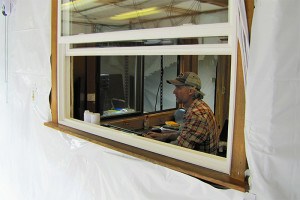
April 20, 2015, Vancouver, Washington. Three years ago, at age 42 and fast approaching 20 years in the mortgage business, Brian Stroh, sold his real estate brokerage firm and after careful research decided to dive into the nascent recreational marijuana business.
Why Marijuana Got Such a Bum Rap and the Eventual Political Repercussions
Following the sad and sordid history of marijuana legislation in the U.S. over the past 75 years—much of the fear and loathing associated with marijuana use had its roots in racist attitudes toward Mexican immigrants in the 1930’s, and negative propaganda intended to protect the powerful interests of the time (from industrial hemp), the lumber and paper industries during the early 20th century.

In 1970, Congress passed the controlled substances act that placed marijuana alongside heroin and cocaine as a Schedule 1 Drug: “classified as having a high potential for abuse, no currently accepted medical use in treatment in the United States, and a lack of accepted safety for use of the drug or other substance under medical supervision.” Not only did this classification make the sale or possession of marijuana a felony under Federal law, it also banned any Federally funded medical research on marijuana despite centuries of evidence suggesting medicinal benefits in many cultures throughout human history.
You May Now Inhale: States Begins to Loosen Their Marijuana Laws
Two states—Washington and Colorado— have legalized recreational marijuana, regulating the possession, distribution and sale of marijuana products to consumers. Alaska allows for the personal possession and the growing of small amounts of marijuana and recently the District of Columbia legalized the possession of small amounts of marijuana for personal use. Oregon’s new recreational marijuana law will take effect in July of this year (2015) and thus will join the ranks of the other two states in regulating the full marijuana trade. California was the first state to legalize the medical use of marijuana in 1996 and there are now 23 states that offer patients the legal right to obtain a doctor’s prescription for medical reasons.
Amidst the backdrop of the gradual easement of marijuana laws across the country, marijuana still remains classified as a schedule 1 drug at the Federal level. This tension between the State and Federal government over marijuana legalization has also contributed to the unintended consequence of inhibiting banks from participating with this emerging industry.
How the Marijuana Industry Is Structured under Washington State’s I-502 Law
In Washington State complete vertical integration is not allowed. The State issues 3 separate licenses: a growers license (for three different tiers) that ultimately determines the maximum production capacity allowable; a producer’s license to process the plants into various finished products: flowers, oils, and edibles; and a retail license to open a store and sell to the public. Though an individual can obtain both a grower and processor license and operate as one business, the retailer’s license must remain entirely separate.

Brian Stroh believes that eventually supplies will greatly increase and price margins will thin out. “I’ve heard wholesale prices of anywhere from 5 to $45 a gram which is incredible. You know the individuals on the low end are probably a little low. The individuals on the high end are out of their mind, but the pricing for the market is like any other market. It will come into balance as supply and demand come into balance,” says Stroh. He expects retail prices to eventually level off, an eighth of an ounce (3.54 grams) resting somewhere in the 60 to $85 price range.
Smoke Gets In Your Eyes
Marijuana advocates are especially bullish on the future for legalized marijuana expanding to other states because of the added potential tax revenues for state coffers. In Washington State, each license holder is taxed at a 25% level, so a grower pays an excise tax of 25% for the value of the products they sell to the processor, the processor pays an additional 25% excise tax to the retailer, and the retailer must tack on their own 25% tax plus the sales tax within their individual city and county. Businesses that hold dual (grower/processor) licenses are able to avoid having to pay both excise tax amounts—they only pay 25%. Of the total in taxes collected, all the excise taxes and much of the sales tax goes to the State. Some are less than happy with the equity of this arrangement and argue that local communities should also receive a share of the 75% excise taxes being levied— as they do with the sales tax component.
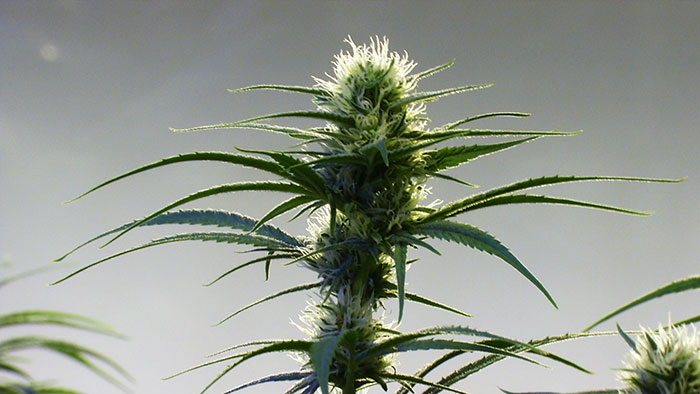
Washington voters also approved I-502 for other reasons. One hope is that regulation will eventually result in a less robust criminal black market trade for marijuana in the State. Legal marijuana prices are too high at the present time to undermine the criminal trade. Young people in general (including the underage population) and those less affluent will likely pursue other means to procure their marijuana than through expensive licensed retail stores. But as the number of growers and processors increases over time, the retail prices will likely decline and at some point begin to siphon off from at-least some illicit sales.
The State controls the retail pricing to the extent that it may modify the excise tax rates to help maintain a state of equilibrium between black market prices and legitimate (taxable) sales once reliable levels of supply enter the licensed marketplace. The State has no inherent interest in seeing marijuana become a relatively inexpensive product that would encourage new drug users (customers) to consume a legal drug. It also means that in order to keep the illegal street value of marijuana high (it’s priced high only because of the special risks involved), it must continue to prosecute those who distribute and procure marijuana outside of the I-502 law.
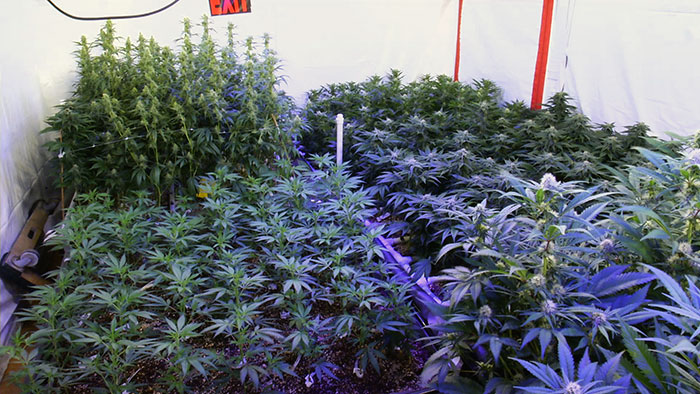
In April of last year, I spoke to Ted Weatherbee, a retail licensee (The Gallery) who felt that the loosely regulated medical marijuana trade contributed a large amount of marijuana to the black market in Washington State. He sees the State eventually closing up the medical marijuana dispensaries and sending medical card-holders to the highly-regulated retail shops to purchase their tax-free marijuana and thus reduce the grey market supply to the criminal element. As yet, that has not happened, though recently the Washington legislature appears poised to tighten some of the medical marijuana requirements.
While I-502 sets a maximum limit of 334 licensed retail stores in the State, there are no fixed limits for the number of grower and processor licenses that will be allowed. As of December of last year, according to the Seattle Times, the State issued 99 retail licenses (not all licensee’s had opened for business), that resulted in almost 65 million in sales beginning in July of 2014. 320 grower licenses were issued over the same period of time while the State took in about 16 million in excise taxes.
Inside a Marijuana Retail Store….
In Vancouver, Washington, the State’s 4th largest city and its oldest, a recreational marijuana business opened its doors in a small nondescript shopping center. New Vansterdam joined the first crop of licensed retailers to open for business when I-502 took effect in July of 2014.
The single door for entry is manned and every customer who enters must show a valid driver’s license though it’s not required that they be a state resident. There’s somewhat of a maze flow to the store’s layout. From the entry way, there’s another door which opens into a room where posters hang from the walls and encased shelves display a variety of packaged marijuana products and paraphernalia. There’s almost a museum like feel to the space as customers are to peruse interesting products geared around (of course) the marijuana plant. Throughout the store, 800 year-old recycled Douglas Fir that was dredged from the Willamette River line the counters and some of the walls.
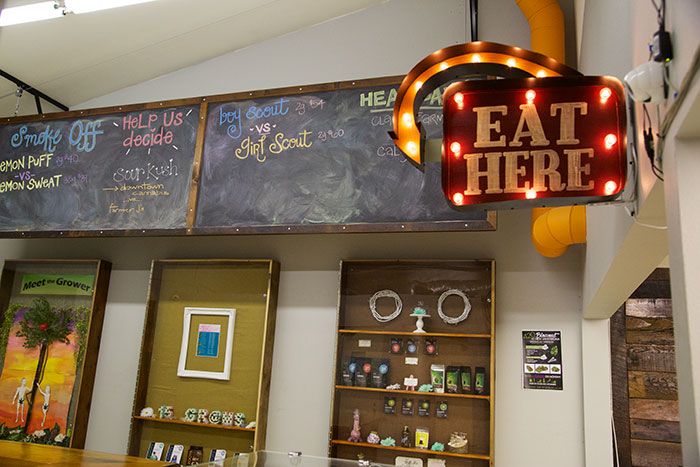
To the immediate right stands a helpful attendant at the ready to answer general questions and perhaps offer some suggestions. I overhear an exchange where a customer inquires about a particular strain of marijuana and wanting to vary the strains so as to avoid achieving a form of “resistance” to the effects of the drug. The attendant agrees, if you smoke the same strain of marijuana over long periods of time, you may become accustomed to its effects.
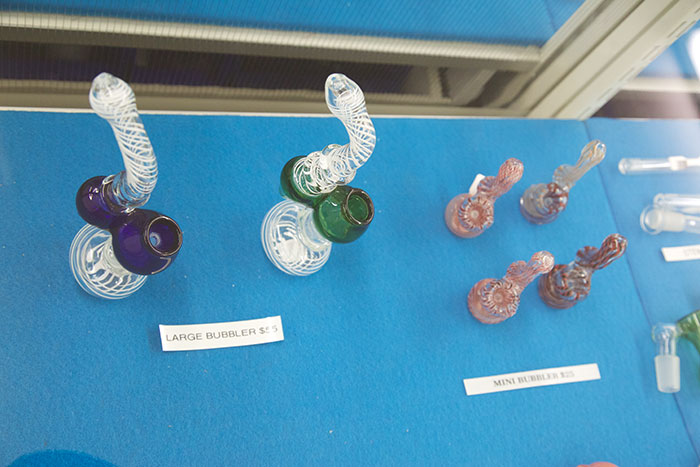
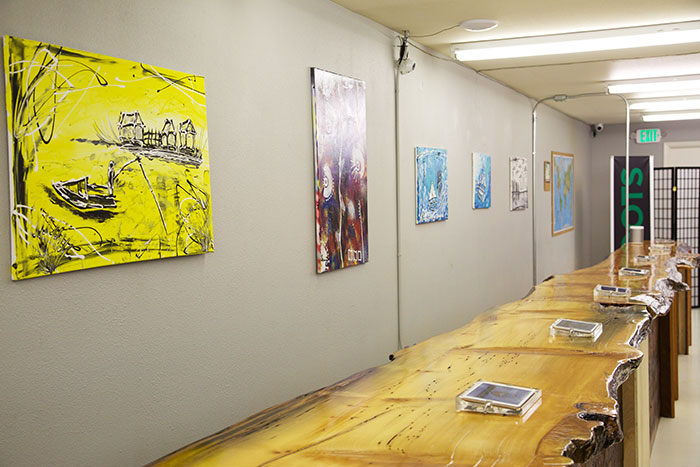
Directly in front of this counter, a long room opens up with enclosed counters on each side displaying a host of marijuana accoutrements. There are printed catalogues of all the actual marijuana products available for purchase. On top of the counters, there are a few sealed cases with magnifying lenses for peering through at particular strains of flowers (buds). This is the only means of viewing a packaged marijuana product until after the purchase is made. iPads dot the counters to provide a hands-on means of acquiring additional information about the growers and different strains. No smoke is present in the air, the staff is friendly, but aside from colorful pictures and posters on the walls and even with the use of the historic wood, there’s an oddly antiseptic feel to the store.
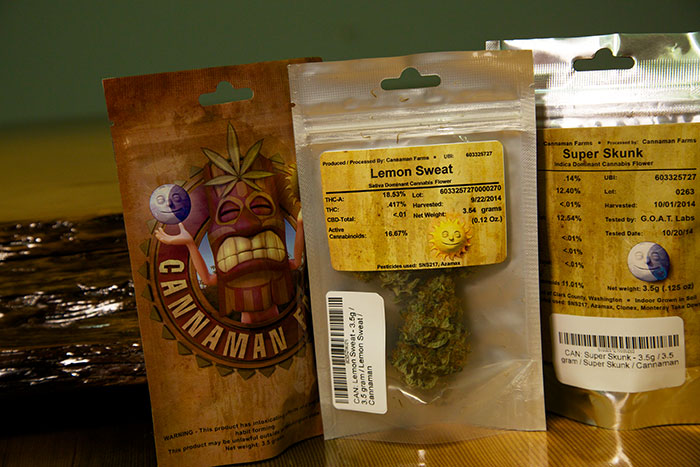
In the final leg of the journey stands the check-out counter. An ATM machine rests quietly nearby along the wall. It’s an all cash business and no names or other customer information are collected at the purchase counter. Once the payment has been made, the customer advances toward another counter where perhaps a 100 different types of packaged marijuana products are for the first time in plain view. The clerk fills the customer’s order, placing their products into a white store bag. Once the order has been completed, the customer travels about 10 feet out a single exit door back out into the parking lot.
The Final Hit
Standing outside New Vansterdam’s taking more pictures, it suddenly struck me— all the hoopla about marijuana for so many years. Instead of the inevitable descent into chaos and madness as so outrageously depicted in “Reefer Madness”, something else entirely. In the place of screaming, screeching and sirens sounding —the softly measured beat of car doors opening and closing in the calm outside air of an ordinary mall.
Additional Resources
- Legal Pot by the Numbers (Seattle Times)
- State Marijuana Laws Map (Governing)
- Marijuana Policy Project
- Reefer Madness Film (Wikipedia)
- Marijuana Timeline (Frontline, PBS)
- Benefit-Cost Analysis of Initiative 502 PDF (University of Washington)
- Mark A.R. Kleiman- Marijuana Public Policy Expert (UCLA Luskin School of Public Affairs)
- Everything You Want To Know About Legal Pot in Washington (Seattle Times)
- The World’s Cannabis Information Resource
- High Times (High Times Magazine)
Most of the videos featured on Cooking Up a Story were produced, filmed, and edited by Rebecca Gerendasy. Fred Gerendasy contributed as a writer to many of the posts and occasionally as the interviewer. Visit Rebecca Gerendasy Clay – Art and Fred Gerendasy Photography to see their current work.
